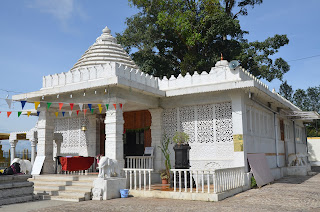Vijayadurga Kshetra --- A Serene and Aesthetic Mecca
Our visit to Sri Vijayadurga Kshtra happens by chance rather than choice. We are on our way to Karkala from Bengaluru when a few kilometers from Hassan, at Aluru, we come upon a sign board on the highway indicating the temple. The decision is instantaneous. We turn right on NH 48 in the direction of Vijayadurga Kshetra and are happy for the halt here.
Peaceful, serene, tranquil – I’m at a loss for words to describe what we experience in this spiritual sprawl. The modern architecture and layout to the shrine complex blends well with its main deities that are 400 years old. A beautifully sculpted archway brings us to a brick tiled car park flanked by lush lawns leading to the octagonal Purushartha Yaga Mantapa. The exterior walls of this yaga shala based on pancha bhootas or the five elements, have niches containing sculptures of nine forms of Goddess Durga.
Directly in front of the Yaga Mantapa is an exquisitely crafted sanctum sanctorum built entirely of white marble. A simple but elegant dhwaja sthamba is erected between the entranceway and the sanctum. The rectangular entrance arch holds aloft Goddess Durga with Ganesha and Anjaneya to her left and right sides respectively.
A picture of
sartorial elegance in white, Shantananda Kshetrapala along with Veerabhadra Bhairava stands
guard on the left of the sanctum in a separate open shrine. Durga Devi's vehicle, a majestic lion in black marble stands regally before the sanctum sanctorum.
An octagonal black pedestal to the right, holds a gently swaying Tulasi, the holy basil plant. Two of its tiers have carvings of elephants and various forms of Durga. Etched on marble, adjacent to the plant, is Tulasi Shloka, which devotees commit to memory. Uniform lattice work panels displaying floral motifs run along the exterior walls of the sanctum, adding to the aesthetics of the edifice.
Sculpted figurines of two forms of Goddess Durga adorn the centre of the sanctum which is a spacious structure in marble. They are flanked by Aiswarya Karpaga Vinayaka on the left, and Ishtasiddhi Anjaneya on the right. The Lakshmi and Vijaya sthambas grace the main altar on either sides.
Decked in pink satin and bedecked in floral finery, a weapons-wielding Durga stands tall and majestic as Sri Udasalamma, symbolizing Shakti, Power, Strength and Bravery. Devotees throng to her abode seeking solace from problems especially associated with justice. A calm and composed Sri Matsalamma, dressed in blue, is seated next to Udasalamma. She is Goddess Durga sitting as a Yogini and represents Soumya Shanti. She indicates permanence and stability with the power to destroy ignorance and bring about self-realization.
The pot-bellied elephant god charms his way to your heart as he sits smug in meditation, holding the Shiva Linga in his right palm. Referred to as Aiswarya Karpaga Vinayaka in this temple, this form of Ganesha’s idol is deemed rare. Perhaps, there is only one other temple in Tamil Nadu that has such a sculpted form of Vigneshwara with the Linga in his hand. The temple priest tells us that devotees praying to Aiswarya Ganesha are bound to be blessed with all forms of wealth, health, peace and prosperity.
Rama Bhakt Hanuman, Ishtasiddhi Anjaneya as he is known here, supposedly fulfils devotees’ cherished desires. We observe several worshippers proceed to a tree behind the temple and tie a talisman obtained from the altar of Anjaneya. The belief is that in doing so, they would have their wishes fulfilled.
The Ishtasiddhi Vriksha, a banyan tree, dates back several centuries. Legend has it that when the blind Anjana Devi performed penance under it, she got back her sight and also mothered the strong and powerful Anjaneya.
Dvishakti, another tree which is over-200-year old tree, is a combination of seven trees. It is believed to protect the main temple deities.
There is an interesting story associated with the 400-year old two main idols of the temple. The statues of Udsalamma and Matsalamma were in a small four-walled building barely measuring 36 sq.ft. The door of this construct was accidentally burnt in a fire from lamps lit in the temple. The incident gave rise to the belief that the fire broke out because of the wrath of the gods due to some misdeed or wrongdoing of unknown nature. Consequently, families presiding over the temple and residing in its vicinity fled the village and resettled elsewhere.
The temple in its present state was given new life by a divine vision that was experienced by one Mr.Sridhar Raj Urs whose family deities or kula devatas were Udsalamma and Matsalamma. With providential guidance, the Urs family located the idols which remained intact though the fire had destroyed large part of the original building where they were housed. The recovered statues were installed in the present precincts, a five-acre stretch of land which is attractively landscaped and comprises the temple, the Yagashala, quarters for temple staff and office building.
Besides daily pujas in the morning and evening, the temple observes with much fanfare Sankranti, Shivaratri, Yugadi, Rama Navami, Gauri-Ganesha, Vaikunta Ekadasi, Hanumath Jayanthi, Dasara and its own anniversary.
*****









































